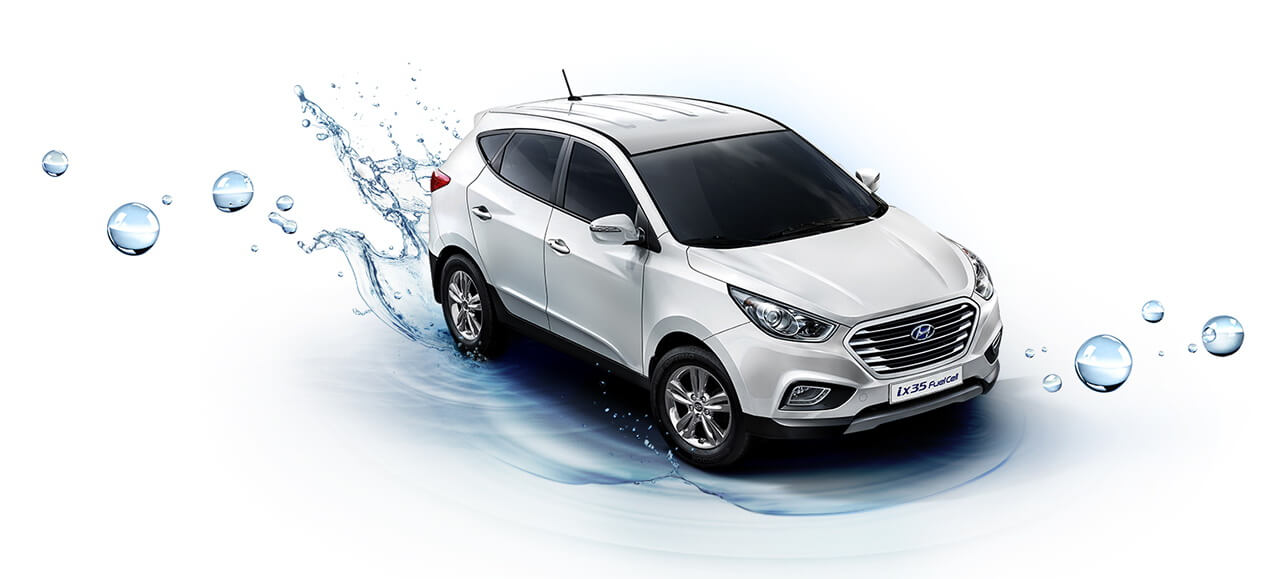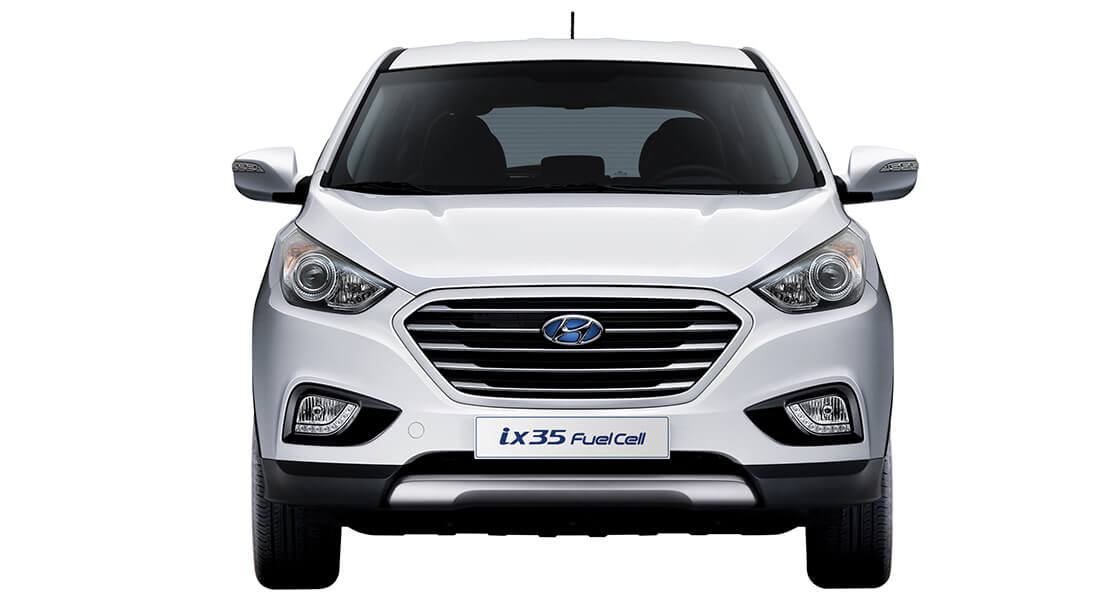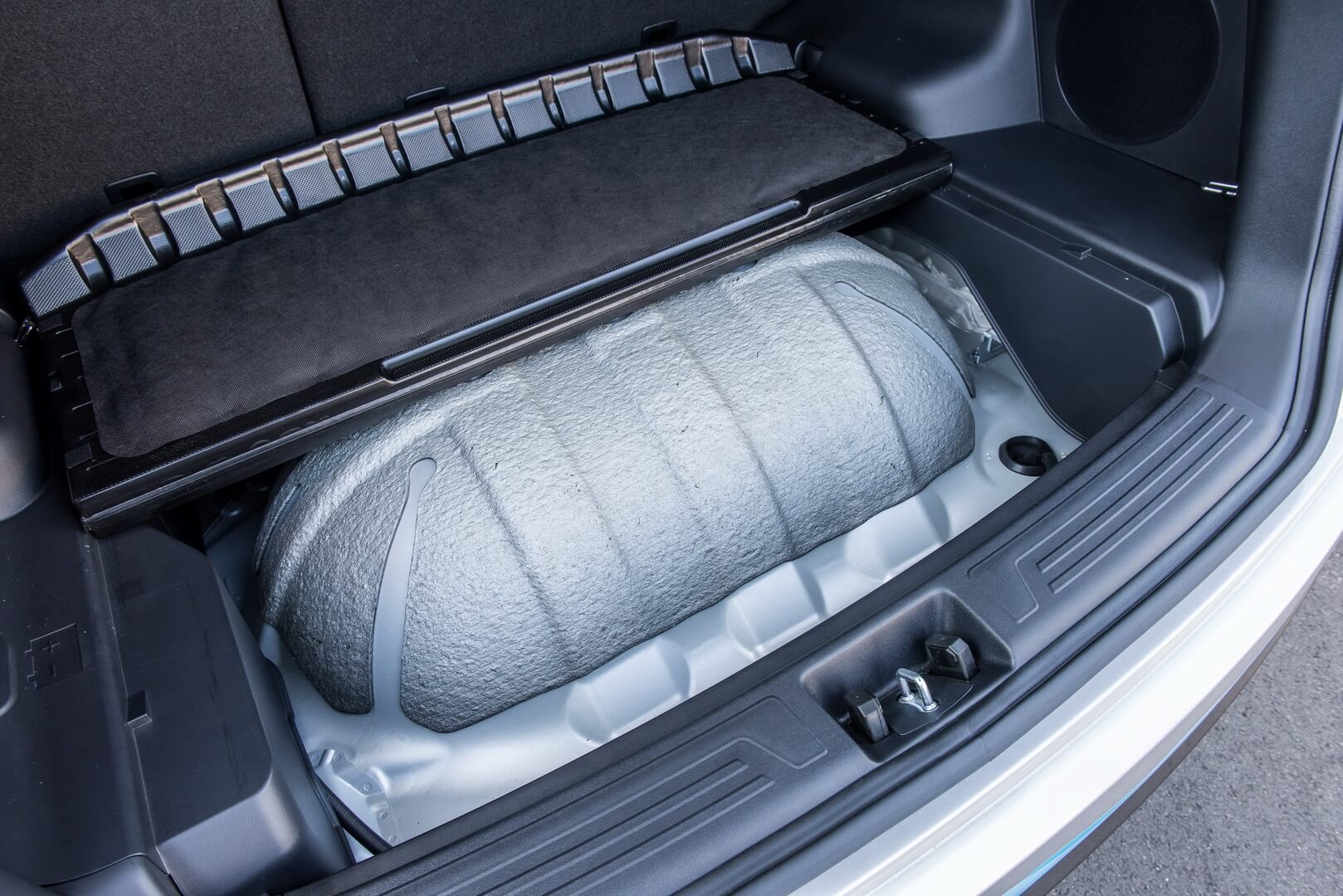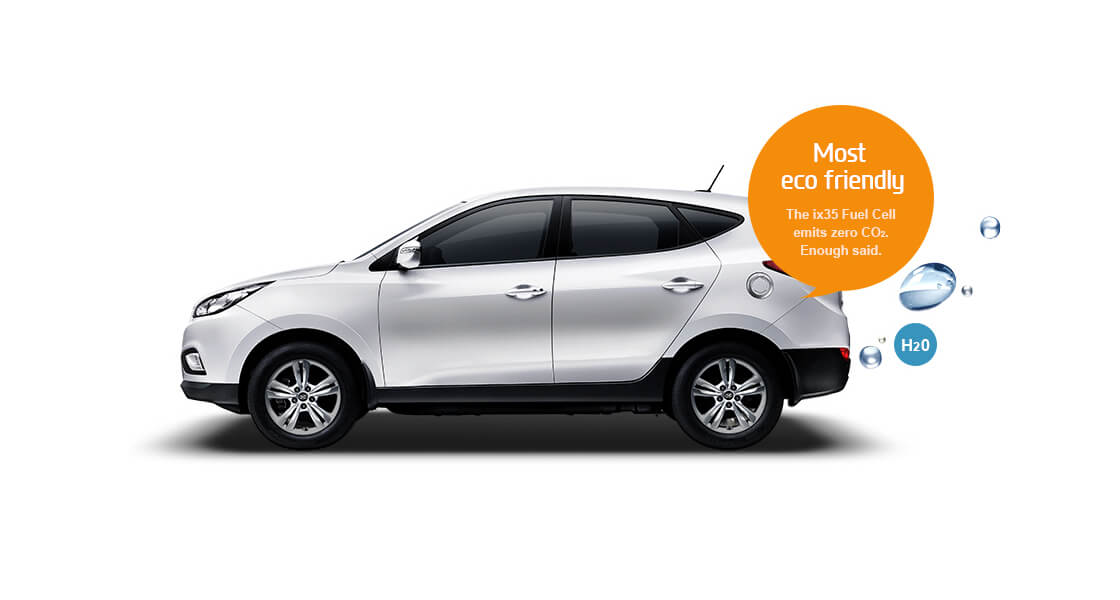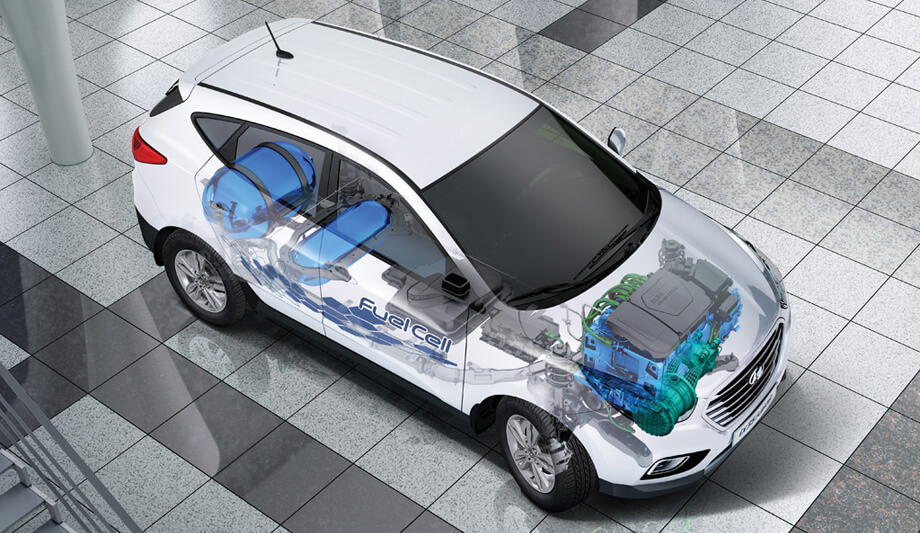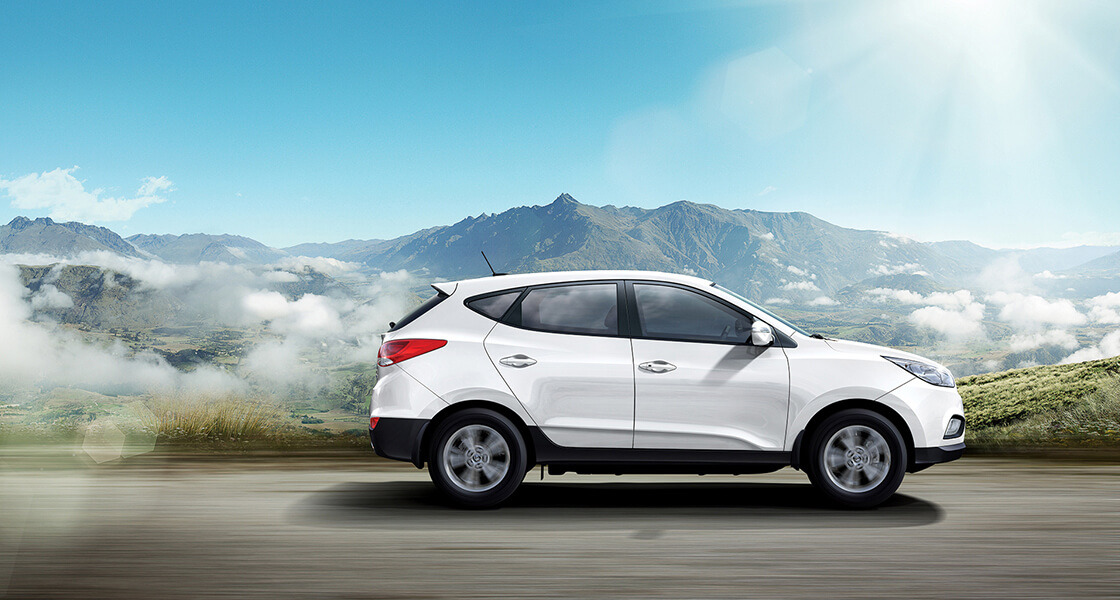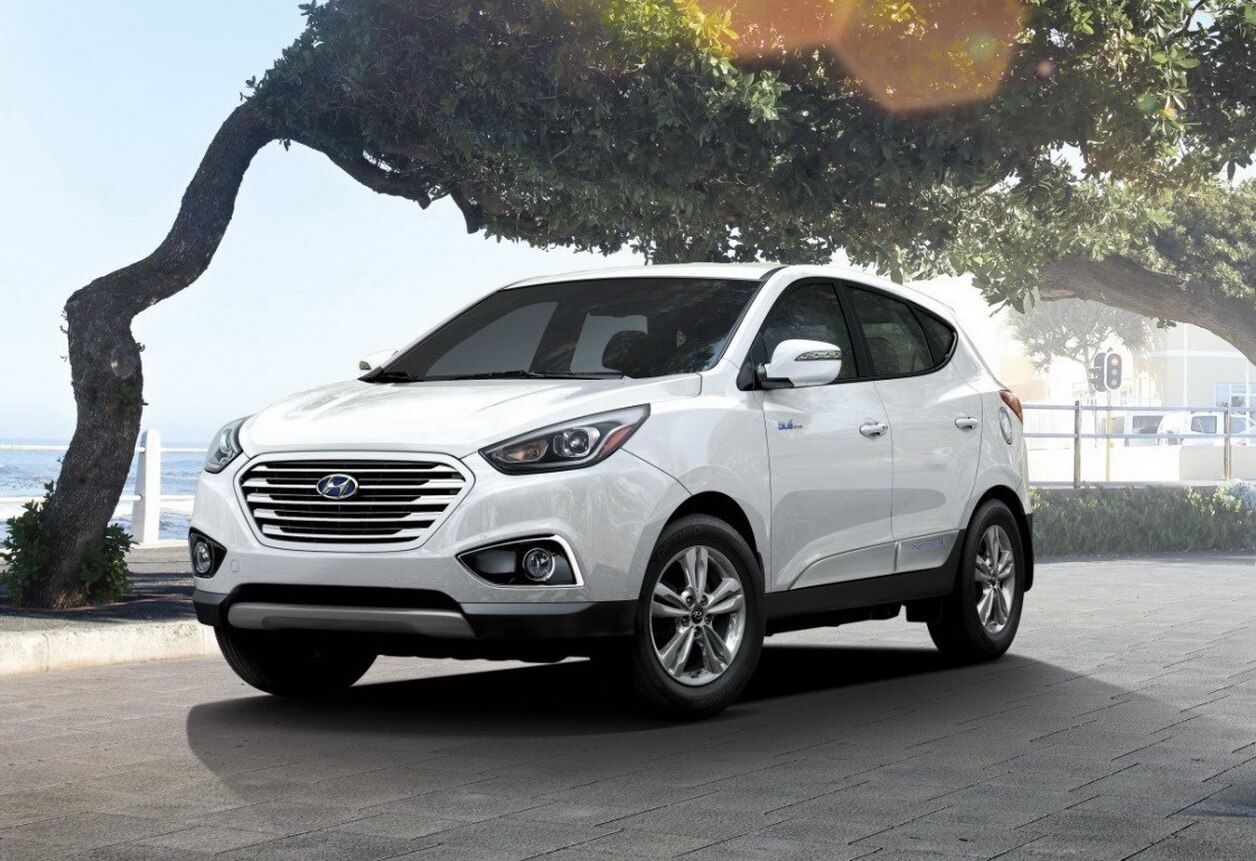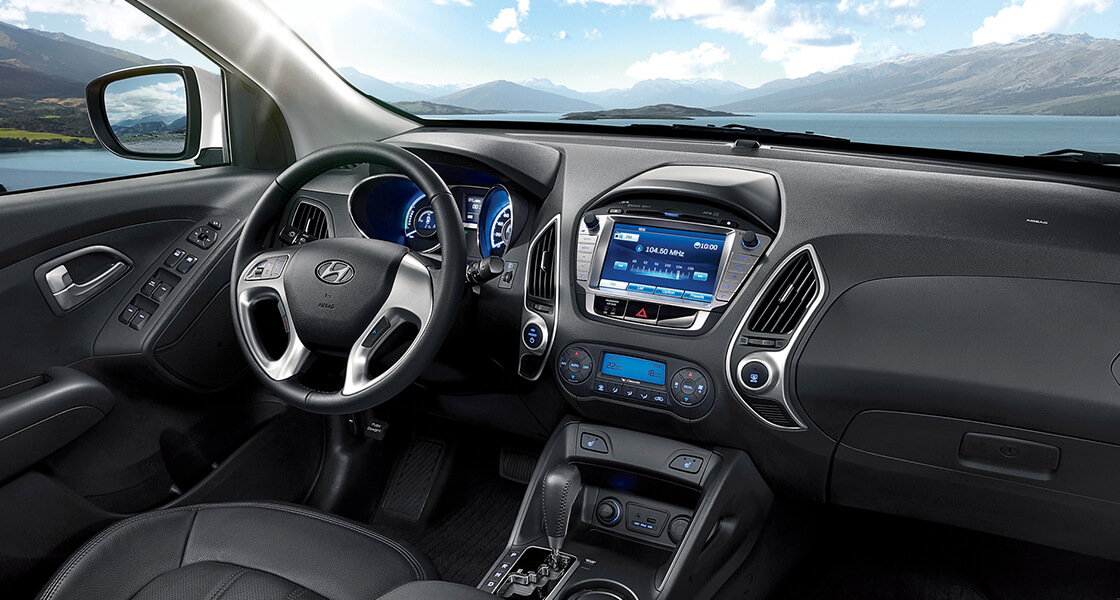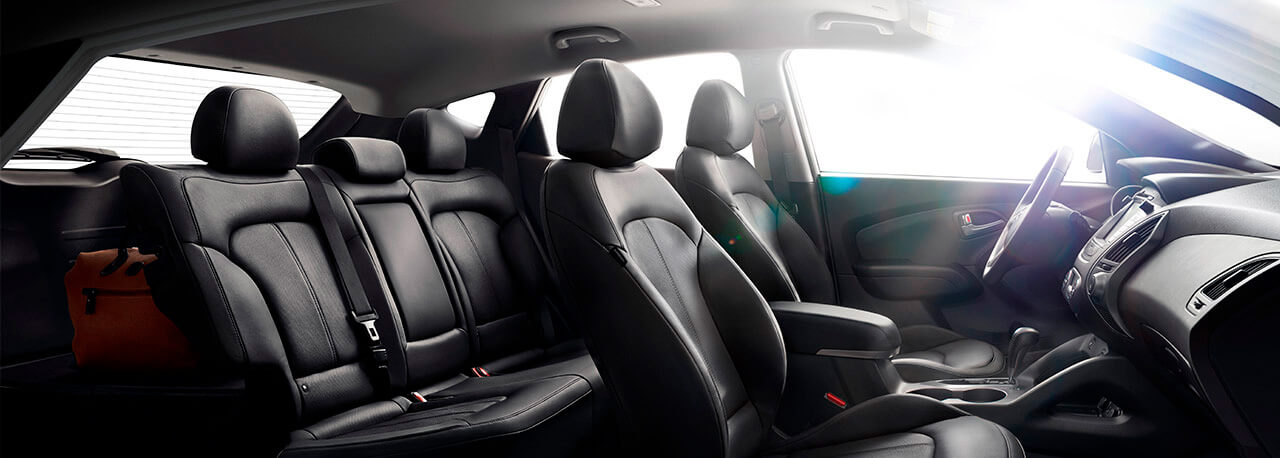- Hyundai Completes Development Of Tucson Ix Hydrogen Fuel-Cell Electric Vehicle
- Hyundai Tucson/ix35 FCEV
- Силовая установка и принцип работы Hyundai Tucson Fuel Cell
- Экстерьер и интерьер Hyundai Tucson/ix35 FCEV
- Ходовые качества электромобиля на топливных элементах Hyundai Tucson/ix35
- Безопасность Hyundai Tucson/ix35 FCEV
- Hyundai Unveils Tucson ix Hydrogen Fuel Cell Electric Vehicle At Fuel Cell Hydrogen Energy 2011
- Hyundai Completes Development Of Tucson Ix Hydrogen Fuel-Cell Electric Vehicle
Hyundai Completes Development Of Tucson Ix Hydrogen Fuel-Cell Electric Vehicle
(Seoul, Korea) Hyundai Motor Company has completed development of its next- generation hydrogen fuel cell vehicle — the Tucson ix Fuel Cell Electric Vehicle — and will begin testing next year with an eye toward 2015 mass production.
Hyundai’s third-generation FCEV is equipped with a 100-kilowatt fuel cell system and two hydrogen storage tanks (700bar). The SUV can travel 650 kilometers on a single charge – a range equal to a gasoline-powered car. It can start in temperatures as low as minus 25 degrees Celsius.
The Tucson ix FCEV’s range is a 76-percent improvement over the second-generation Tucson FCEV, which was limited to 370 kilometers on one charge. The new model gets gasoline equivalent fuel efficiency of 31 kilometers per liter, a 15-percent improvement over the previous version.
More than 95 percent of the Tucson ix FCEV’s major components were made with Korean technology through close collaboration with about 120 domestic auto parts manufacturers. Overall volume of the fuel cell system was downsized by 20-percent compared to the previous system via modularization of bulky parts in the fuel cell system including fuel cell stack, balance of plant(BOP), inverter and high voltage junction box.
Hyundai took part in the `Learning Demonstration Program’ organized by the U.S. Department of Energy between 2004 and 2009. Next year, 48 Tucson ix FCEV’s will be part of a `Domestic Fleet Program’ supported by the Korean government.
Its hydrogen vehicles have so far registered more than 2 million kilometers. Hyundai plans to make a limited supply of the Tucson ix FCEV in 2012 and begin mass production in 2015. Hyundai unveiled a cutaway version of the vehicle at the Geneva Motor Show in March.
※ Comparison of new Tucson ix FCEV (3 rd generation) and Tucson FCEV (2 nd generation)
CLASSIFICATION
Tucson
FCEV
Hyundai Tucson/ix35 FCEV
Hyundai Tucson Fuel Cell (ix35 FCEV) — первый автомобиль на топливных элементах, который по словам корейского производителя наряду с электромобилями олицетворяет будущее автомобилестроения.
Hyundai Tucson Fuel Cell или Hyundai ix35 FCEV © hyundainews.com
Силовая установка и принцип работы Hyundai Tucson Fuel Cell
Внутри и снаружи Hyundai ix35 Fuel Cell полностью идентичен обычному Hyundai ix35 вплоть до рычага автоматического переключения передач. Однако под внешней оболочкой это совершенно другой автомобиль.
Электромобиль на топливных элементах Hyundai ix35 FCEV © hyundainews.com
Топливо, а именно сжатый водород под давлением 700 атмосфер, размещается в двух газовых баллонах расположенных вместо обычного бензобака, один на 40 литров перед задней осью, второй на 104 литра позади нее.
Водородный баллон расположенный под багажным отделением Hyundai Tucson Fuel Cell © hyundainews.com
Топливный элемент располагается под капотом. Гибридные аккумуляторные батареи расположены под транспортным средство и сосредоточены по центру общей конструкции для лучшего распределения массы авто. Внутри топливного элемента используются анодные и катодные пластины, и мембрана из полимерного электролита.
Продукт «выхлопа» Hyundai Tucson Fuel Cell — обыкновенная вода © hyundainews.com
Когда водород протекает по аноду, он расщепляется на протоны водорода и электроны. Мембрана из полимерных материалов пропускает исключительно протоны. Электроны перемещаются к внешней цепи, которая управляет двигателем. На катоде электроны и протоны реагируют с кислородом, создавая воду, как результат реакции и побочный продукт.
Баллоны с водородом под давлением 700 атмосфер в задней части кузова Hyundai Tucson/ix35 FCEV © hyundainews.com
Компактный внедорожник использует 0,95 кг водорода на 100 километров.
Аккумуляторная батарея используются для поддержки работы системы топливных элементов, а также для генерации энергии рекуперативного торможения.
Экстерьер и интерьер Hyundai Tucson/ix35 FCEV
Экстерьер электромобиля на топливных элементах Hyundai ix35 Fuel Cell © hyundainews.com
Снаружи Hyundai Tucson/ix35 Fuel Cell — это обычный ix35, сохраняющий компактные размеры полюбившегося многими кроссовера. В этом главная особенность автомобиля, который полностью поменяв природу трансмиссии, визуально остался прежним. Основное отличие от оригинала снаружи — это функциональная радиаторная решетка (в большинстве электромобилей в нет необходимости) за которой расположено два радиатора, один для охлаждения топливных элементов, другой для традиционных систем, таких как кондиционер и другие.
Экстерьер электромобиля на топливных элементах Hyundai Tucson Fuel Cell © hyundainews.com
Внутри изменений больше и прежде всего они касаются панели приборов, но в целом все узнаваемо. Самое большое «разочарование» интерьера — уменьшенный на 150 литров из-за наличия большого топливного баллона в задней части авто — объем багажника.
Панель приборов водородного кроссовера Hyundai © hyundainews.com
Салон водородного кроссовера Hyundai © hyundainews.com
Ходовые качества электромобиля на топливных элементах Hyundai Tucson/ix35
Самый главный плюс Hyundai ix35 Fuel Cell это доступный сразу весь крутящий момент. Не то чтобы он был слишком проворным, все таки более чем на 100 кг тяжелее обычного ix35, и на 1,5 секунды медленнее, тем не менее он чувствует себя абсолютно комфортно в городской среде для которой он впрочем и предназначен.
Работа силового агрегата обеспечивает необходимый рабочий ритм для комфортной езды в разных ситуациях, нет недостатка в мощности, как нет и лишнего резерва, те кто пользовался обычным Hyundai ix35 могут и не заметить разницы.
Безопасность Hyundai Tucson/ix35 FCEV
В отличии от обычных авто с ДВС, потенциальных владельцев Hyundai ix35 Fuel Cell FCEV интересует вопрос их безопасности в контексте использования водорода, как опасного топлива.
Отмечаем, что водород сохраняется в двух баллонах изготовленных из алюминиевого сплава и углеродного композита, которые прошли многочисленные испытания и проверки, включая практические испытания на разрыв под давлением выше их рабочих показателей, испытания со сценариями всевозможных аварий и даже испытания со стрельбой. После них всех баллоны были сертифицированы как безопасные для массового производства.
В качестве стандартных систем безопасности Hyundai ix35 Fuel Cell FCEV включает:
- 6 подушек безопасности;
- активный подголовник — корректирующий свое положение с учетом веса и роста человека, с целью максимального предотвращения травмы шеи;
- 4 водородных датчика следящих за возможной утечкой топлива.
| Тип топлива | Водород |
| Максимальный крутящий момент электромотора | 221 Нм |
| Коробка передач | Автоматическая |
| Передняя подвеска | McPherson |
| Размеры передних шин | 215/70 R16 |
| Размеры задних шин | 215/70 R16 |
| Количество мест | 5 |
| Количество дверей | 5 |
| Длина | 4410 мм |
| Ширина | 1820 мм |
| Высота | 1670 мм |
| Колея передних колес | 1591 мм |
| Колея задних колес | 1592 мм |
| Полная масса | 1830 кг |
| Объём топливного бака | 140 л |
- экономичность;
- отсутствие вредных выбросов;
- прогрессивная трансмиссия;
- безопасность.
- Марка Hyundai
- Модель Tucson
- Тип кузова Кроссовер
- Вид Водородный
- Двигатель Электрический
- Мощность электродвигателя 134 л.с./100 кВт
- Батарея 0.95 кВт•ч
- Запас хода (NEDC/EPA/WLTP) 594 км
- Разгон 0-100 км/ч 12.5 c
- Максимальная скорость 160 км/ч
Hyundai Unveils Tucson ix Hydrogen Fuel Cell Electric Vehicle At Fuel Cell Hydrogen Energy 2011
Washington, DC, Feb. 14, 2011 – Hyundai Motor America continues its commitment to fuel economy leadership and alternative fuel technology with the introduction of the next-generation hydrogen fuel cell vehicle, the Tucson ix Fuel Cell Electric Vehicle (FCEV). The Tucson ix FCEV makes its U.S. public debut at Fuel Cell & Hydrogen Energy 2011 in Washington, DC and will be on display Feb. 14-16.
“We are excited to share the latest in Hyundai’s fuel cell technology,” said Dr. Tae Won Lim, Managing Director of Hyundai Motor Company’s Fuel Cell Vehicle Group. “After several years of testing, we have identified ways to maximize fuel efficiency without compromising driving experience and powertrain range. We hope to continue this momentum in finding ways to better fuel cell technology and performance.”
Hyundai’s third-generation FCEV is equipped with its newest 100-kilowatt fuel cell system and two hydrogen storage cylinders (700bar) to deliver a substantial improvement in fuel efficiency. The Tucson ix FCEV can travel more than 400 miles on a single fueling, a 76-percent improvement over its predecessor, and a range equal to a gasoline-powered car. It achieves gasoline equivalent fuel efficiency of more than 70 miles per gallon, a 15-percent improvement over the previous version. It can also start in temperatures as low as minus 25 degrees Celsius.
In addition to improving the fuel economy and range of the powertrain, Hyundai has also created a more compact power source for the Tucson ix FCEV. Overall volume of the fuel cell system was downsized by 20-percent compared to the previous system via modularization of bulky parts in the fuel cell system including fuel cell stack, balance of plant (BOP), inverter and high voltage junction box.
Hyundai will test about 50 new Tucson ix FCEVs throughout 2011 as part of the second phase of the Korean Government Validation Program. Hyundai plans to make a limited supply of the Tucson ix FCEV in 2012 and begin mass production in 2015.
Comparison of new Tucson ix FCEV (3 rd generation) and Tucson FCEV (2 nd generation)
| CLASSIFICATION | Tucson ix FCEV | Tucson FCEV | |
| SPECIFICATIONS | Fuel Cell Stack | 100kW | 100kW |
| Drive System | 100kW | 100kW | |
| Energy Storage System | 21kW (※ Battery) | 100kW (※ Super Capacitor) | |
| Hydrogen Storage System | 700bar (Hydrogen : 5.6kg) | 350bar (Hydrogen : 3.5kg) | |
| PERFORMANCE | Maximum Speed | 100 mph | 100 mph |
| Gasoline Equivalent Fuel Efficiency | 72 mpg | 63 mpg | |
| Max. Driving Distance per single refueling | 403 mi | 230 mi | |
“The Tucson ix FCEV shows that Hyundai is taking a multi-faceted approach to improving fuel economy, developing hydrogen fuel cell vehicles along with its patented Blue Drive technology,” said John Juriga, Powertrain Director at Hyundai Kia America Technical Center, Inc. “Hyundai is committed to developing a diverse portfolio of fuel efficient options for our customers, as seen with our Sonata Hybrid, turbocharged Gasoline Direct Injection (GDI) engine and the all-new 1.8-liter Nu engine delivering 40 mpg highway for the Elantra. The introduction of the new FCEV is just another example of all the things we’re doing to increase the ecological friendliness and the fuel economy of our products.”
Hyundai Completes Development Of Tucson Ix Hydrogen Fuel-Cell Electric Vehicle
(Seoul, Korea) Hyundai Motor Company has completed development of its next- generation hydrogen fuel cell vehicle — the Tucson ix Fuel Cell Electric Vehicle — and will begin testing next year with an eye toward 2015 mass production.
Hyundai’s third-generation FCEV is equipped with a 100-kilowatt fuel cell system and two hydrogen storage tanks (700bar). The SUV can travel 650 kilometers on a single charge – a range equal to a gasoline-powered car. It can start in temperatures as low as minus 25 degrees Celsius.
The Tucson ix FCEV’s range is a 76-percent improvement over the second-generation Tucson FCEV, which was limited to 370 kilometers on one charge. The new model gets gasoline equivalent fuel efficiency of 31 kilometers per liter, a 15-percent improvement over the previous version.
More than 95 percent of the Tucson ix FCEV’s major components were made with Korean technology through close collaboration with about 120 domestic auto parts manufacturers. Overall volume of the fuel cell system was downsized by 20-percent compared to the previous system via modularization of bulky parts in the fuel cell system including fuel cell stack, balance of plant(BOP), inverter and high voltage junction box.
Hyundai took part in the `Learning Demonstration Program’ organized by the U.S. Department of Energy between 2004 and 2009. Next year, 48 Tucson ix FCEV’s will be part of a `Domestic Fleet Program’ supported by the Korean government.
Its hydrogen vehicles have so far registered more than 2 million kilometers. Hyundai plans to make a limited supply of the Tucson ix FCEV in 2012 and begin mass production in 2015. Hyundai unveiled a cutaway version of the vehicle at the Geneva Motor Show in March.
※ Comparison of new Tucson ix FCEV (3 rd generation) and Tucson FCEV (2 nd generation)
CLASSIFICATION
Tucson
FCEV
